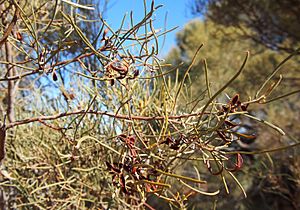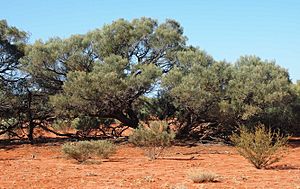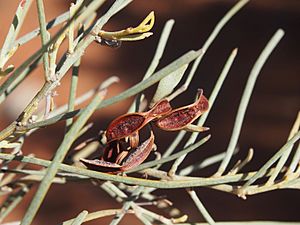Shrubby wattle facts for kids
Quick facts for kids Shrubby wattle |
|
|---|---|
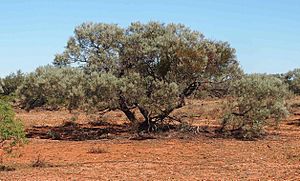 |
|
| Scientific classification | |
| Genus: |
Acacia
|
| Species: |
calcicola
|
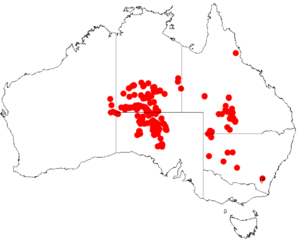 |
|
| Occurrence data from AVH | |
Acacia calcicola is a shrub or tree from the Acacia family, often called the shrubby wattle. It grows naturally in the dry, central parts of Australia. This plant has many common names, including shrubby mulga, myall-gidgee, northern myall, and grey myall. Different Indigenous Australian groups also have their own names for it. The Pitjantjatjara people call it ikatuka, the Warlpiri call it jirlarti, and the Arrernte know it as irrakwetye.
What Does Shrubby Wattle Look Like?
The shrubby wattle is usually a rounded or sprawling shrub or tree. It can grow to be about 1.5 to 6 meters (5 to 20 feet) tall. Often, it has several stems coming from its base, with a wide, bushy top.
Its leaves are not typical flat leaves. Instead, they are flattened leaf stems called phyllodes. These phyllodes can be narrow and long, or sometimes slightly wider and oval-shaped. They are usually straight or slightly curved. Each phyllode is about 5 to 14 centimeters (2 to 5.5 inches) long and 1 to 10 millimeters (0.04 to 0.4 inches) wide.
The shrubby wattle blooms in spring, from September to November. It produces bright yellow flowers. These flowers grow in round clusters, each about 3 to 4 millimeters (0.12 to 0.16 inches) across. Each cluster can have between 30 and 60 golden flowers.
Later, after the flowers, seed pods form. These pods are about 12 centimeters (4.7 inches) long and 5 to 8 millimeters (0.2 to 0.3 inches) wide. They are woody and look wrinkled over the seeds inside. The seeds themselves are dull brown, oval-shaped, and about 6 to 8 millimeters (0.2 to 0.3 inches) long.
This plant is similar to Acacia cana, which has silvery young phyllodes. It is also related to Acacia coriacea, but that plant has longer phyllodes.
How Did Shrubby Wattle Get Its Name?
The scientific name calcicola comes from the word "calcareous," which means it grows in soils rich in lime or calcium. This is because the shrubby wattle is often found in these types of soils.
The plant was first officially described in 1958. Two botanists, Neville Forde and Ernest Horace Ising, wrote about it in a scientific paper. Before this, some people mistakenly thought it was another plant called Acacia coriacea.
Later, in 1987, another botanist named Leslie Pedley gave it a different scientific name, Racosperma calcicola. However, in 2006, it was put back into the Acacia group, which is its current scientific name.
Where Does Shrubby Wattle Grow?
The shrubby wattle is found across the dry central parts of Australia. You can mostly see it in the southern Northern Territory and the Goldfields area of Western Australia. There are also smaller groups of these plants in south-west Queensland and north-west New South Wales.
It likes to grow along temporary waterways that only flow after rain. It also grows on sandy hills that have been worn down. You'll find it in areas with low, open woodlands and tall, open shrublands. It grows especially well in heavy, lime-rich soils, often over limestone. It is frequently found growing near another type of wattle called Acacia aneura.


